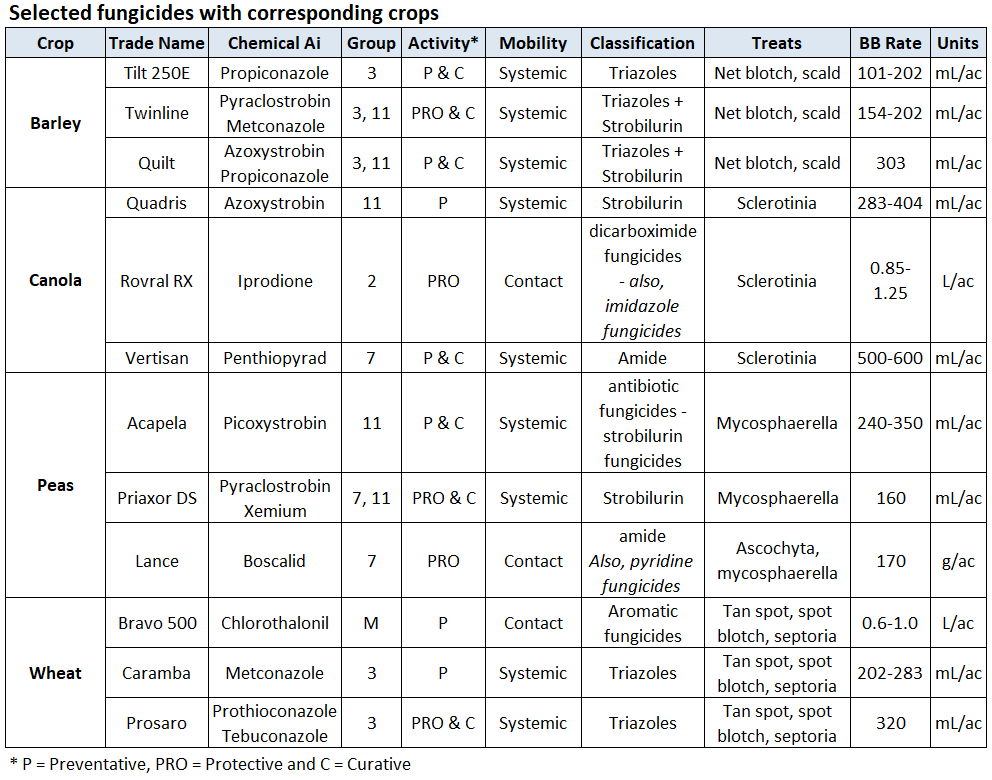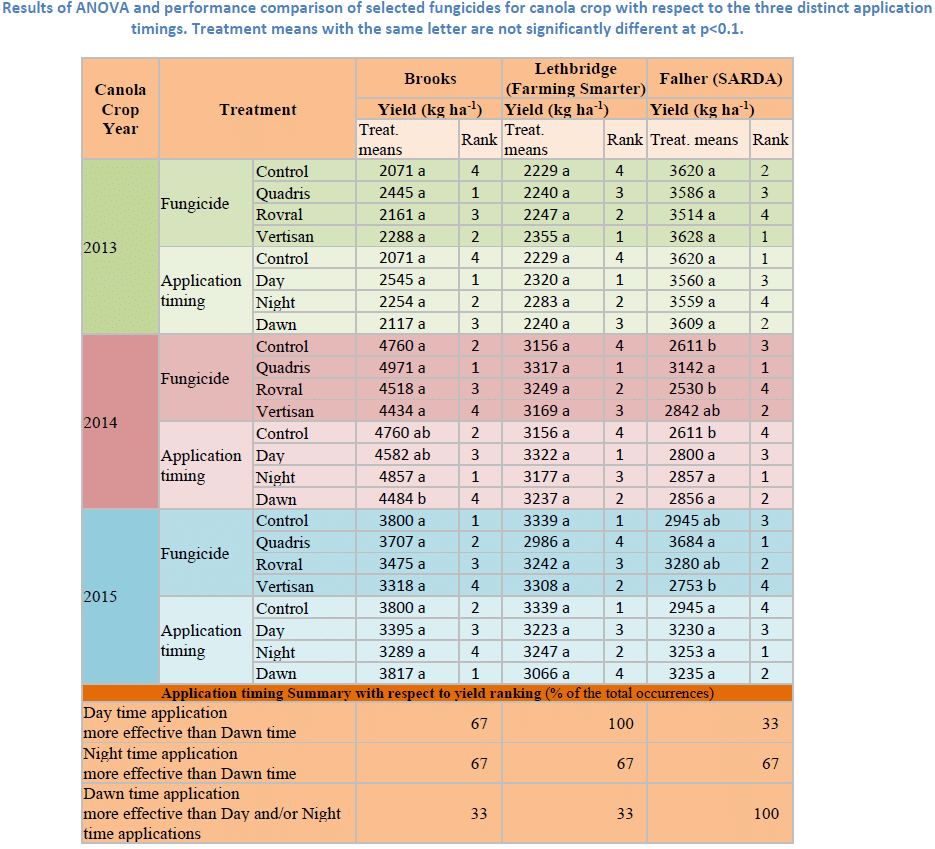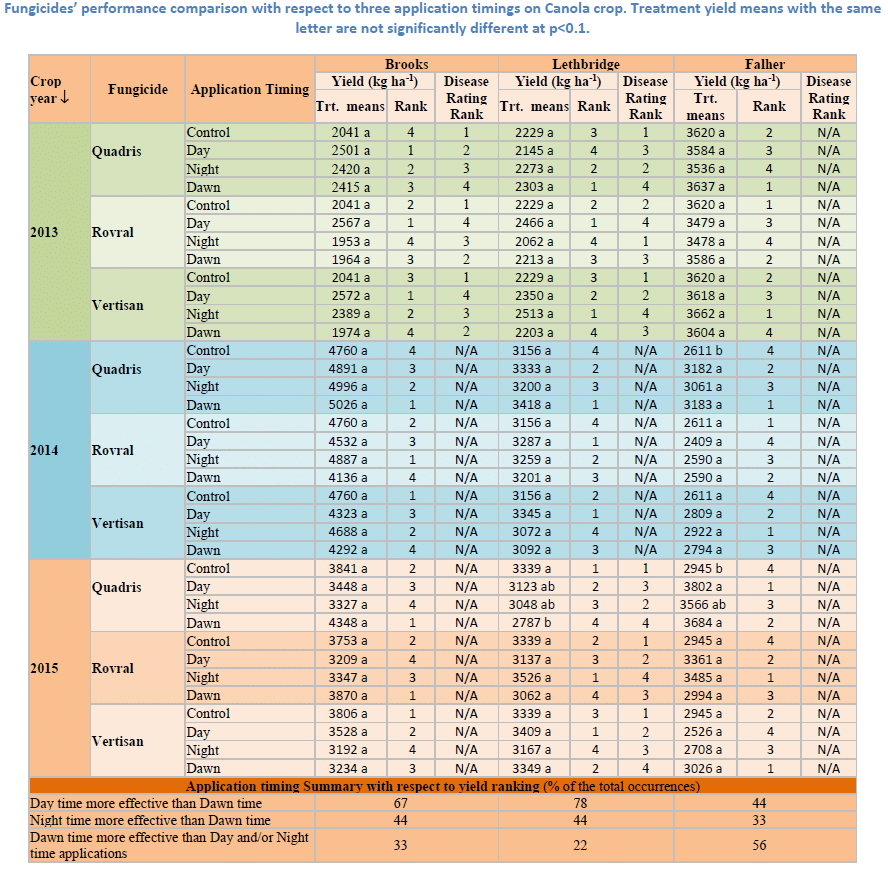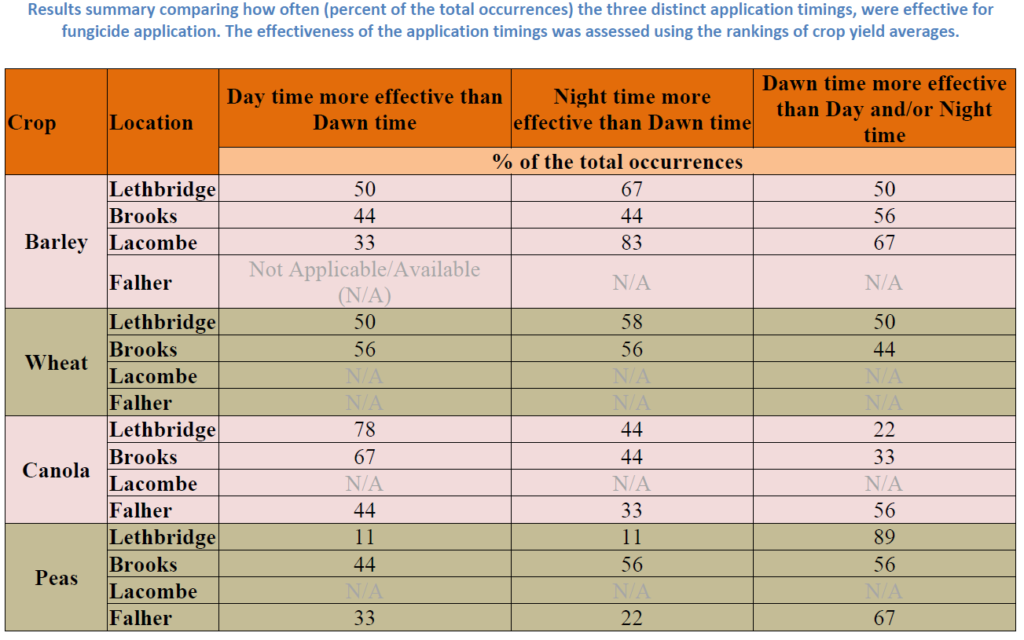Key Result
Crops are not likely to respond to fungicide applications under low disease pressures and will most likely maintain yield potential close to the pre-disease level. Therefore, producers could avoid unnecessary fungicides expenses under low disease severity without facing the risk of losing any yields while saving time, financial resources and the environment.
Fungicides applied during the day, night or dawn would be similarly effective on barley, wheat and canola, with some advantage of dawn or night time applications for peas.
Project Summary
Overview
Application timing can significantly alter pesticide effectiveness. Due to Alberta’s short growing seasons, most producers seed and spray in a very short time frame. This is especially challenging for those who have increased acres without increasing equipment inventory. As a result, growers often have to juggle weather conditions, environmental consequences and economic considerations when choosing pesticide application timing.
Poor day time conditions, such as hot and windy conditions, can greatly reduce fungicide efficacy, which can quickly diminish financial returns on investment, particularly in Alberta due to the short growing season. So the cooler temperatures, less wind, higher humidity and lower evaporation potential that occurs at night and dawn time were considered as alternative.
This study examined night and dawn time applications as a practical alternative to the daytime spray application, as there is limited scientific research and huge knowledge gaps exist in this area.
Objectives
The main study goal is to provide detailed information from a systematic, science-based approach on the effects of night spraying using fungicides currently registered in Alberta on common cereal and canola diseases. Specific objectives are to:
- Evaluate efficacy and crop tolerance of fungicides applied at three distinct times.
- Understand the linkages between environmental conditions and fungicide efficacy.
- Quantify potential yield effects, quality and return on investment resulting from fungicide applications.
Trial design and methods
The study ran for three crop years from 2013 to 2015, including 472 small research plots established at four locations each year: Farming Smarter Association (FS) site in Lethbridge, Crop Diversification Centre (CDC) South in Brooks, Agriculture and Agri-Food Canada (AAFC) Centre in Lacombe and at Smoky Applied Research and Demonstration Association (SARDA) in Falher, Alberta.

Four crops, barley, wheat, canola and peas, were used. However, not all four crops were tested at each location. All trials were designed as randomized split-plots with four replicates, using five fungicide treatments with different modes of action, three spray timings (dawn, noon, midnight) and two water volumes/and or nozzle types. Plots were sprayed using hand held sprayers equipped with two meter booms, CO2 propellant and low drift nozzles to minimize drift. Herbicide labels informed the spray rates, application timing and other considerations. Nozzles were spaced 50 cm apart and held 50 cm above the canopy. Plot dimensions, number of rows, row spacing etc. were adjusted to accommodate different seeding and spraying equipment.
Crops were evaluated for cereal leaf diseases, including tan spot, septoria and scald in wheat and barley and sclerotinia stem rot and blackleg in canola. When appropriate, crops were inoculated with corresponding pathogens to ensure sufficient disease pressure. To create conditions conducive to infection and disease development, some plots received irrigation.
Data collection for each spray treatment included air and crop canopy temperatures, sunlight hours, cloud cover, relative humidity, overnight dew, soil temperature, wind speed and direction, disease symptoms present, growth stage, and pictures. Researchers evaluated plots for disease control (incidence and severity) and crop tolerance (phytotoxicity) at standard intervals (3-5 days, 7-14 days, 21+ days after fungicide application). Leaf samples went for laboratory analysis and pathogen confirmation. Data collection included yield and grain quality data.
Results
Disease pressure

The disease severity ratings results indicated that, on average, disease pressure was low on all crops and crop damage did not seem critical across all locations. Because crops respond to fungicides application when severely damaged from the high pressure of foliar diseases, low levels of disease severity with noncritical crop damage could mute crops’ response to fungicides (Dokken-Bouchard, 2015; Hershman, 2011; Paul et al., 2011; Swoboda and Pedersen, 2009).
On the average, yields corresponded with the in-season crop disease ratings in <40% of the instances. This low level of correspondence between disease ratings and yield means could be because of low disease pressures during the period of the study. Because when disease pressure is slight, ratings may not be able to reflect the variation in the yield. The results further illustrate this fact when out of 79 instances the yield followed the corresponding disease ratings, 44 of those instances (~56%) were paired up as 14, i.e., highest yield (1) and lowest disease severity (4), or as 41, i.e., lowest yield (4) and highest disease severity (1).
Fungicide efficacy on crop yields
Overall, Quadris was the most effective treatment for canola, producing the highest yields over three years at Brooks, in 2014 at Lethbridge and in 2014 and 2015 at Falher. For application timings, day and night times were equally effective in 67% of the instances at Brooks, day time in 100% of the time at Lethbridge and dawn time 100% of the time at Falher. Dawn time scored the least at Brooks and Lethbridge and day time at Falher.

In conclusion, the results show that Twinline, Prosaro, Quadris and Prixor were most effective fungicides for barley, wheat, canola and peas, respectively. However, most of these results lacked statistical significance (p=0.01). One apparent reason for yields response to fungicides treatments lacking statistical significance was the low disease severity that couldn’t cause critical injury to crops and crops response to fungicides’ applications. These results agree with several other researchers who recommend using fungicides only when damage to crop is critical and significant loss of yield potential is eminent (Bradley, 2012; Hershman, 2011; Paul et al., 2011).
Effect of fungicide application timing on crop yields
The overall effects of fungicides and application timings on crop yields were weak due to low disease severity across all locations.
For canola, relatively strong trends in application timing frequencies showed at two locations, Lethbridge and Brooks with day time most frequently effective (78% and 67%, respectively) followed by the night and dawn times, respectively (day time > night time > dawn time). At Falher, however, dawn time scored better in 56% of the instances compared to 44 and 33% for day and night times, respectively.
Conclusions and recommendations
- Severity of fungal diseases remained low for all crops and across all locations during the 3-year study period.
- Crops yields were not affected by fungicides statistically. By extension, it means that under low levels of disease conditions, producers could avoid using fungicides without losing any yield potential while saving time, financial resources and the environment.
- In general, Twinline, Prosaro, Quadris and Prixor were most effective fungicides for barley, wheat, canola and peas, respectively.
- For barley, day time was the least effective application timing at all locations.
- Dawn applications at Brooks were most effective (56% of the instances) for producing higher yields compared to day and night times that both scored at 44%.
- Night time application was most effective at Lethbridge at (67% of the instances) compared to day and dawn timings (scoring 50% each).
- Night applications also scored higher yields at Lacombe (83% of the instances) followed by the dawn time (67%) and day time (33%).

- For wheat, no application timing seemed clearly effective.
- For canola, day time application was most frequently effective at Lethbridge and Brooks (78% and 67%, respectively) followed by the night and dawn times, respectively (day time > night time > dawn time).
- Dawn time scored better at Falher in 56% of the instances compared to 44 and 33% for day and night times, respectively.
- For peas, dawn time and night time applications were effective. This is likely because of pea canopy structure and the diurnal folding of leaves in the absence of daylight allowed deeper fungicide penetration with increased fungicide residual activity within the bottom canopy.
- These results require further research for verification because trends in treatment means differences with respect to the application timings were not statistically significant at p=0.1
In general, the study results suggest that fungicides applied during the day, night or dawn time would be similarly effective on barley, wheat and canola, with some advantage of dawn or night time applications for peas. However, because of low disease pressure, the study could not maximize the differences between treatments. Further research might verify these results.
References
- Bradley, C.A. 2012. Factors Considered When Making Corn Foliar Fungicide Application Decisions in Illinois. J. Extension: 50(3), http://www.joe.org/joe/2012june/rb7.php
- Dokken-Bouchard, F. 2015. Making fungicide application decisions in dry conditions. CROP PRODUCTION NEWS #3 – JULY 7, 2015, Govt. of Saskatchewan (accessed on April 18, 2016 at URL: http://www.agriculture.gov.sk.ca/cpn1507-Fungicide-Decisions-Dry-Conditions).
- Hershman, D.E. 2011, Fungicide use in wheat. Plant Pathology Fact Sheet (PPFS-AG-SG-05), UK Coop. Extension Service, Univ. of Kentucky. USA.
- Paul, P. A., Madden, L. V., Bradley, C. A., Robertson, A. E., Munkvold, G. P., Shaner, G., Wise, K. A., Malvick, D. K., Allen, T. W., Grybauskas, A., Vincelli, P., and Esker, P. 2011. Meta-analysis of yield response of hybrid field corn to foliar fungicides in the U.S. Corn Belt. Phytopathology 101:1122-1132.
- Swoboda, C. and P. Pedersen. 2009. Effect of fungicide on soybean growth and yield. Agron. J. 101:352-356.
Related research
Night spraying: Pesticide efficacy with night time applications





